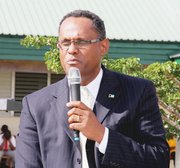By DENISE MAYCOCK
Tribune Freeport Reporter
dmaycock@tribunemedia.net
GRAND Bahama Minister Dr Michael Darville continues to stand behind a report which downplayed pollution concerns on the island, despite strong rejection expressed by the Pinder’s Point/Lewis Yard Environmental Committee, which is still calling for the relocation of residents in communities surrounding the industrial plants.
The PPLYEC - which has held a series of protests against the government, industrial plants, and the Grand Bahama Port Authority - does not accept the report’s findings that there is no environmental or health risks to persons living near the industrial plants.
The report was prepared by the Pan American Health Organisation (PAHO) World Health Organisation (WHO).
“I stand by those reports until someone else can bring scientific evidence to refute (it),” Dr Darville told The Tribune.
He stressed that personal opinions or statements, and accusations are just not enough.
“Once you bring the information, then the government will be compelled to review the information you bring; not just say it, but bring scientific proof that goes in contrary to what we have done in Pinder’s Point and Lewis Yard by the Pan American Health Organisation and World Health Organisation - these are not guys off the street, these are reputable organisations.”
Dr Darville said that he wanted to make sure that the study was conducted independently, with no influence by the government or industrial plants.
“No one can say industry or government has had any influence - what you see is what they gave us,” he said.
Concerns over industrial pollution have been a sore issue for more than 30 years for the residents of Pinder’s Point, Lewis Yard, Seaco Town, Hunters/Mack Town, and Hawksbill.
In addition to the ongoing alleged exposure to chemical emissions and oil spills, residents also complained of various health issues, including respiratory problems, as well as skin, nose, and eye irritations. They believe that the high incidents of cancer among residents are linked to the industrial emissions.
Last week, the PPLYEC claimed that the results of an epidemiological study, undertaken almost 28 years ago in relation to the effects of the industrial plants on residents, was never made public.
The group has tried to get a hold of the report without much success, has called for the results to be made public.
When asked about “the missing” epidemiological report, Dr Darville explained that the report was turned over, with others, to the PAHO/WHO team brought over in 2014-2015 to conduct an environmental and health risk assessment study of communities near the industrial park.
The 1989 report was the first major study conducted to looking into the health complaints of the residents, as well as teachers and students at nearby schools.
Dr Darville indicated that all reports that were done by the government, including that first report, was passed on as knowledge to the PAHO/WHO team to review, along with them doing their research.
“That (first report) was part of the final completion of the PAHO/WHO report to my knowledge. Reports and investigations were done all the way back when Dr Norman Gay was the minister of health. We had all that information compiled, and it was reviewed and forwarded to directly to those consultants who used it as part of the final conclusion of the report that was published by us,” he said.
Dr Darville shared the findings of the PAHO/WHO report in Parliament in June 2016 during his contribution to the 2016/2017 Budget Debate.
Dr Darville stressed that accusations that are being made about him are not true.
“I can understand them saying, ‘I do not accept the content of the report,’ but to say that I am callous and I am not concerned, I think is going a bit far and it is completely far from the truth,” he pointed out.
“My concern is the people of Grand Bahama and their safety which includes me and my family. I take it very personally because it is personal attack against me, and it has nothing to do with the facts.
“I am concerned. If I was not concerned I would not put the weight of government resources behind the research. Secondly, I am very concerned because I live in Grand Bahama; and thirdly, I practice medicine in this community for many years. This is the reason I wanted to have an evidence-based report that had scientific parameters in place, and try to listen carefully to the concerns of the community, but at the same time take a scientific approach to analysing the entire issue as it relates to safety and environmental concerns.”
The PAHO/WHO report also included two recommendations: ongoing air quality monitoring, and to undertake a safety assessment study in the communities, with respect to their proximity to the industrial park.
An E-nose system has already been implemented in the communities and the industrial park sector to monitor air quality. And on Friday, the government contracted the Antea Group of the Netherlands to undertake a 10-13 week safety assessment of the Pinder’s Point, Lewis Yard and Hawksbill communities.





Comments
Use the comment form below to begin a discussion about this content.
Sign in to comment
Or login with:
OpenID